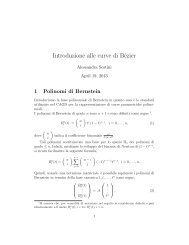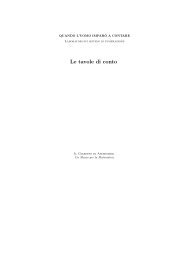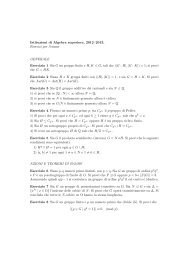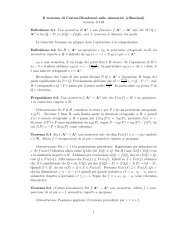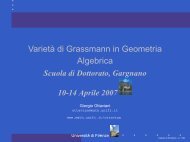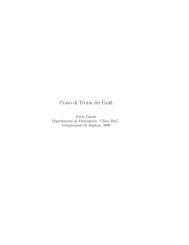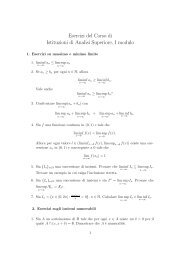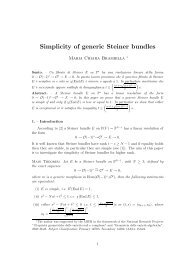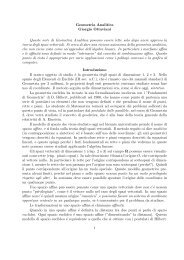Tesi di Laurea di Valentina Boccini - Dipartimento di Matematica e ...
Tesi di Laurea di Valentina Boccini - Dipartimento di Matematica e ...
Tesi di Laurea di Valentina Boccini - Dipartimento di Matematica e ...
Create successful ePaper yourself
Turn your PDF publications into a flip-book with our unique Google optimized e-Paper software.
CAPITOLO 3. COMPLEMENTI AL TEOREMA DI BARNING 86<br />
Esistono tre possibili terne (a, b, c) ∈ P P T tali che S(a, b, c) = (a ′ , b ′ , c ′ ).<br />
Per la prima parte del teorema, esistono solo tre possibili punti<br />
tali che T (x, y) = (x ′ , y ′ );<br />
(x, y) = a b , c c<br />
questi possibili punti sono tutti a coor<strong>di</strong>nate entrambe razionali.<br />
Perciò, se (x, y) ∈ Q ha almeno una coor<strong>di</strong>nata irrazionale, allora T (x, y)<br />
non può avere entrambe le coor<strong>di</strong>nate razionali.<br />
Lo sviluppo <strong>di</strong> (x, y) è una sequenza finita se e solo se, per un certo n ∈ N,<br />
che equivale alla con<strong>di</strong>zione:<br />
T n (x, y) ∈ Q \ Q = {(1, 0), (0, 1)},<br />
T n−1 (x, y) ∈<br />
<br />
3 4 4 3<br />
, , , .<br />
5 5 5 5<br />
Poiché però abbiamo scelto (x, y) con almeno una coor<strong>di</strong>nata irrazionale,<br />
questo non può accadere per nessun valore <strong>di</strong> n: la trasformazione T può<br />
essere applicata quin<strong>di</strong> un numero illimitato <strong>di</strong> volte, essendo sempre definita.<br />
In questo caso quin<strong>di</strong> lo sviluppo è sempre una sequenza infinita.<br />
Dimostriamo adesso che questa sequenza non può terminare con una successione<br />
infinita <strong>di</strong> 3. Definiamo a questo scopo una funzione G che sia la<br />
corrispondente <strong>di</strong> T dal punto <strong>di</strong> vista dell’angolo delle coor<strong>di</strong>nate polari<br />
, in cui può variare questo angolo, viene<br />
dei punti su Q. L’intervallo 0, π<br />
normalizzato a (0, 1).<br />
Sia t ∈ (0, 1) :<br />
Definiamo F (t) := cos πt<br />
2<br />
2<br />
<br />
πt , sin ; 2<br />
G : (0, 1) → [0, 1]<br />
G := F −1 ◦ T ◦ F<br />
(0, 1) è sud<strong>di</strong>viso in tre zone, I1, I2, I3, corrispondenti a quelle in cui è<br />
sud<strong>di</strong>viso Q, nella definizione <strong>di</strong> d.<br />
I3 =<br />
<br />
0, 2<br />
π arctan<br />
<br />
3<br />
2<br />
; I2 =<br />
4<br />
π arctan<br />
I1 =<br />
È imme<strong>di</strong>ato verificare che:<br />
<br />
2<br />
π arctan<br />
<br />
4<br />
, 1 .<br />
3<br />
<br />
3<br />
,<br />
4<br />
2<br />
π arctan<br />
<br />
4<br />
;<br />
3




